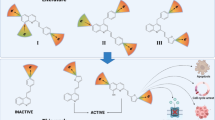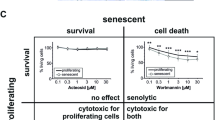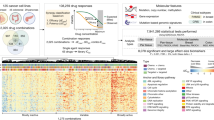Abstract
Proteins belonging to the ras superfamily are involved in cell proliferation of normal and neoplastic tissues. To be biologically active, they require post-translational isoprenylation by farnesyl-transferase and geranylgeranyl-transferase. Enzyme inhibition by drugs may thus represent a promising approach to the treatment of cancer. Therefore, the combined effect of BAL9611, a novel inhibitor of geranylgeranylation, and manumycin, a farnesyl-transferase inhibitor, was evaluated on the SW620 human colon cancer cell line which harbours a mutated K-ras gene. BAL9611 and manumycin dose-dependently inhibited SW620 cell growth with 50% inhibitory concentration (IC50) of 0.47 ± 0.03 and 5.24 ± 1.41 μM (mean ± SE), respectively. The isobologram analysis performed at the IC50 level revealed that the combined treatment was highly synergistic with respect to cell growth inhibition. BAL9611 and manumycin were able to inhibit the geranylgeranylation of p21rhoA and farnesylation of p21ras; both drugs inhibited p42ERK2/MAPK phosphorylation, but their combination was more effective than either drug alone. Moreover, the enhanced inhibition of cell growth in vitro by the BAL9611-manumycin combination was also observed in vivo in CD nu/nu female mice xenografted with SW620 tumours. Finally, both drugs were able to induce cell death by apoptosis in vitro and in vivo, as demonstrated by perinuclear chromatin condensation, cytoplasm budding and nuclear fragmentation, and interoligonucleosomal DNA digestion. In conclusion, the inhibition of protein farnesylation enhances the chemotherapeutic effect of BAL9611 in vitro and in vivo in a synergistic fashion, as a result of the impairment of post-translational isoprenylation of proteins and phosphorylation of p42ERK2/MAPK, whose activation is associated with post-translational geranylgeranylation and farnesylation of p21rhoA and p21ras. © 2001 Cancer Research Campaign http://www.bjcancer.com
Similar content being viewed by others
Article PDF
Change history
16 November 2011
This paper was modified 12 months after initial publication to switch to Creative Commons licence terms, as noted at publication
References
Campbell SL, Khosravi-Far R, Rossman KL, Geoffrey JC and Der CJ (1998) Increasing complexity of Ras signaling. Oncogene 17: 1395–1413
Danesi R, Figg WD, Reed E and Myers CE (1995) Paclitaxel (Taxol®) inhibits protein isoprenylation and induces apoptosis in PC-3 human prostate cancer cells. Mol Pharmacol 47: 1106–1111
Danesi R, Nardini D, Basolo F, Del Tacca M, Samid D and Myers CE (1996) Phenylacetate inhibits protein isoprenylation and growth of the androgen-independent LNCaP prostate cancer cells transfected with the T24 Ha-ras oncogene. Mol Pharmacol 49: 972–979
Di Paolo A, Danesi R, Nardini D, Bocci G, Innocenti F, Fogli S, Barachini S, Marchetti A, Bevilacqua G and Del Tacca M (2000) Manumycin inhibits ras signal transduction pathway and induces apoptosis in COLO320-DM human colon tumour cells. Br J Cancer 82: 905–912
Fu HW and Casey PJ (1999) Enzymology and biology of CaaX protein prenylation. Recent Prog Horm Res 54: 315–342
Gandhi A, Holland PA, Knox WF, Potten CS and Bundred NJ (1998) Evidence of significant apoptosis in poorly differentiated ductal carcinoma in situ of the breast. Br J Cancer 78: 788–794
Greco WR, Bravo G and Parsons JC (1995) The search for synergy: a critical review from a response surface perspective. Pharmacol Rev 47: 331–385
Hara M, Kazuhito A, Akinaga S, Okabe M, Nakano H, Gomez R, Wood D, Uh M and Tamanoi F (1993) Identification of ras farnesyltransferase inhibitors by microbial screening. Proc Natl Acad Sci USA 90: 2281–2285
Hirai A, Nakamura S, Noguchi Y, Yasuda T, Kitagawa M, Tatsuno I, Oeda T, Tahara K, Terano T, Narumiya S, Kohn LD and Saito Y (1997) Geranylgeranylated Rho small GTPases(s) are essential for the degradation of p27Kip1 and facilitate the progression from G1 to S phase in growth-stimulated rat FRTL-5 cells. J Biol Chem 272: 13–16
Hsueh C-T, Chiu C-F, Kelsen DP and Schwartz GK (2000) Selective inhibition of cyclooxygenase-2 enhances mitomycin-C-induced apoptosis. Cancer Chemother Pharmacol 45: 389–396
James GL, Goldstein JL and Brown MS (1995) Polylysine and CVIM sequences of K-RasB dictate specificity of prenylation and confer resistance to benzodiazepine peptidomimetic. in vitro. J Biol Chem 270: 6221–6226
James GL, Goldstein JL and Brown MS (1996) Resistance of K-RasBv12 proteins to farnesyltransferase inhibitors in Rat1 cells. Proc Natl Acad Sci USA 93: 4454–4458
Kaibuchi K, Kuroda S and Amano M (1999) Regulation of the cytoskeleton and cell adhesion by the rho family GPTases in mammalian cells. Annu Rev Biochem 68: 459–486
Kainuma O, Asano T, Hasegawa M, Kenmochi T, Nakagohri T, Tokoro Y and Isono K (1997) Inhibition of growth and invasive activity of human pancreatic cancer cells by a farnesyltransferase inhibitor, manumycin. Pancreas 15: 379–383
Lebowitz PF and Prendergast GC (1998) Non-ras targets of farnesyltransferase inhibitors: focus on rho. Oncogene 17: 1439–1445
Macchia M, Jannitti N, Gervasi G and Danesi R (1996) Geranylgeranyl diphosphate-based inhibitors of post-translational geranylgeranylation of cellular proteins. J Med Chem 39: 1352–1356
Macchia M, Balsamo A, Macchia B, Baldacci M, Danesi R and Del Tacca M (1997) Novel geranylgeranyl-derivatives, process for the preparation thereof and related pharmaceutical compositions. WO 9719091
Marchetti A, Buttitta F, Pellegrini S, Chella A, Bertacca G, Filardo A, Tognoni V, Ferreli F, Signorini E, Angeletti CA and Bevilacqua G (1996) Bronchioloalveolar lung carcinomas: K-ras mutations costant events in the mucinous subtype. J Pathol 179: 254–259
Marshall CJ (1996) Ras effectors. Curr Opin Cell Biol 8: 197–204
McGuire TF, Qian Y, Vogt A, Hamilton AD and Sebti SM (1996) Platelet-derived growth factor receptor tyrosine phosphorylation requires protein geranylgeranylation but not farnesylation. J Biol Chem 271: 27402–27407
Minamoto T, Mai M and Ronai Z (2000) K-ras mutation: early detection in molecular diagnosis and risk assessment of colorectal, pancreas and lung cancers-A review. Cancer Detect Prev 24: 1–12
Miquel K, Pradines A, Sun J, Qian Y, Hamilton AD, Sebti SM and Favre G (1997) GGTI-298 induces G0-G1 block and apoptosis whereas FTI-277 causes G2-M enrichment in A549 cells. Cancer Res 57: 1846–1850
Olson MF, Ashworth A and Hall A (1995) An essential role for rho, rac and cdc42 GPTases in cell cycle progression through G1. Science 269: 1270–1272
Olson MF, Paterson HF and Marshall CJ (1998) Signals from Ras and Rho GTPases interact to regulate expression of p21Waf1/Cip1. Nature 394: 295–299
Prendergast GC, Khosravi-Far R, Solski PA, Kurzawa H, Lebowitz PF and Der CJ (1995) Critical role for Rho in cell transformation by oncogenic Ras. Oncogene 10: 2289–2296
Rowinsky EK, Windle JJ and Von Hoff DD (1999) Ras protein farnesyltransferase: a strategic target for anticancer therapeutic development. J Clin Oncol 17: 3631–3652
Sah VP, Seasholtz TM, Sagi SA and Brown JH (2000) The role of Rho in G protein-coupled receptor signal transduction. Annu Rev Pharmacol Toxicol 40: 459–489
Seasholtz TM, Majumdar M and Heller Brown J (1999) Rho as mediator of G protein-coupled receptor signaling. Mol Pharmacol 55: 949–956
Sinensky M (2000) Recent advances in the study of prenylated proteins. Biochim Biophys Acta 1484: 93–106
Steel GG and Peckham MJ (1979) Exploitable mechanisms in combined radiotherapy-chemotherapy: the concept of additivity. Int J Radiat Oncol Biol Phys 5: 85–91
Sun J, Qian Y, Hamilton AD and Sebti AM (1998) Both farnesyltransferase and geranylgeranyltransferase I inhibitors are required for inhibition of oncogenic K-Ras prenylation but each alone is sufficient to suppress human tumor growth in nude mouse xenografts. Oncogene 16: 1467–1473
Sun J, Blaskovich MA, Knowles D, Qian Y, Ohkanda J, Bailey RD, Hamilton AD and Sebti SM (1999) Antitumor efficacy of a novel class of non- thiol-containing peptidomimetic inhibitors of farnesyltransferase and geranylgeranyltransferase I: combination therapy with the cytotoxic agents cisplatin, Taxol, and gemcitabine. Cancer Res 59: 4919–4926
Tomayko MM and Reynolds CP (1989) Determination of subcutaneous tumor size in athymic (nude) mice. Cancer Chemother Pharmacol 24: 148–154
Vogt A, Qian Y, McGuire TF, Hamilton AD and Sebti SM (1996) Protein geranylgeranylation, not farnesylation, is required for the G1 to S phase transition in mouse fibroblasts. Oncogene 13: 1991–1999
Zohn IM, Campbell SL, Khosravi-Far R, Rossman KL and Der CJ (1998) Rho family proteins and ras transformation: the RHOad less traveled gets congested. Oncogene 17: 1415–1438
Zujewski J, Horak ID, Bol CJ, Woestenborghs R, Bowden C, End DW, Piotrovsky VK, Chiao J, Belly RT, Todd A, Kopp WC, Kohler DR, Chow C, Noone M, Hakim FT, Larkin G, Gress RE, Nussenblatt RB, Kremer AB and Cowan KH (2000) Phase I and pharmacokinetic study of farnesyl protein transferase inhibitor R115777 in advanced cancer. J Clin Oncol 18: 927–941
Author information
Authors and Affiliations
Rights and permissions
From twelve months after its original publication, this work is licensed under the Creative Commons Attribution-NonCommercial-Share Alike 3.0 Unported License. To view a copy of this license, visit http://creativecommons.org/licenses/by-nc-sa/3.0/
About this article
Cite this article
Paolo, A., Danesi, R., Caputo, S. et al. Inhibition of protein farnesylation enhances the chemotherapeutic efficacy of the novel geranylgeranyltransferase inhibitor BAL9611 in human colon cancer cells. Br J Cancer 84, 1535–1543 (2001). https://doi.org/10.1054/bjoc.2001.1820
Received:
Revised:
Accepted:
Published:
Issue date:
DOI: https://doi.org/10.1054/bjoc.2001.1820
Keywords
This article is cited by
-
Role of non-canonical post-translational modifications in gastrointestinal tumors
Cancer Cell International (2023)
-
Phosphatase of regenerating liver-3 (PRL-3) is associated with metastasis and poor prognosis in gastric carcinoma
Journal of Translational Medicine (2013)
-
Geranylgeranyl Diphosphate Synthase: An Emerging Therapeutic Target
Clinical Pharmacology & Therapeutics (2011)
-
Post-translational modifications and regulation of the RAS superfamily of GTPases as anticancer targets
Nature Reviews Drug Discovery (2007)
-
Fluvastatin enhancement of trastuzumab and classical cytotoxic agents in defined breast cancer cell lines in vitro
Breast Cancer Research and Treatment (2007)



